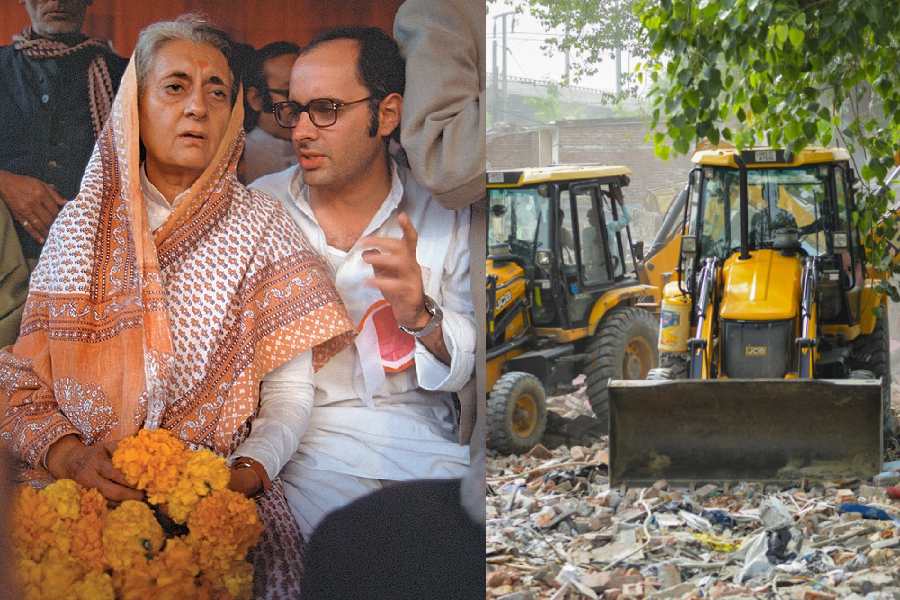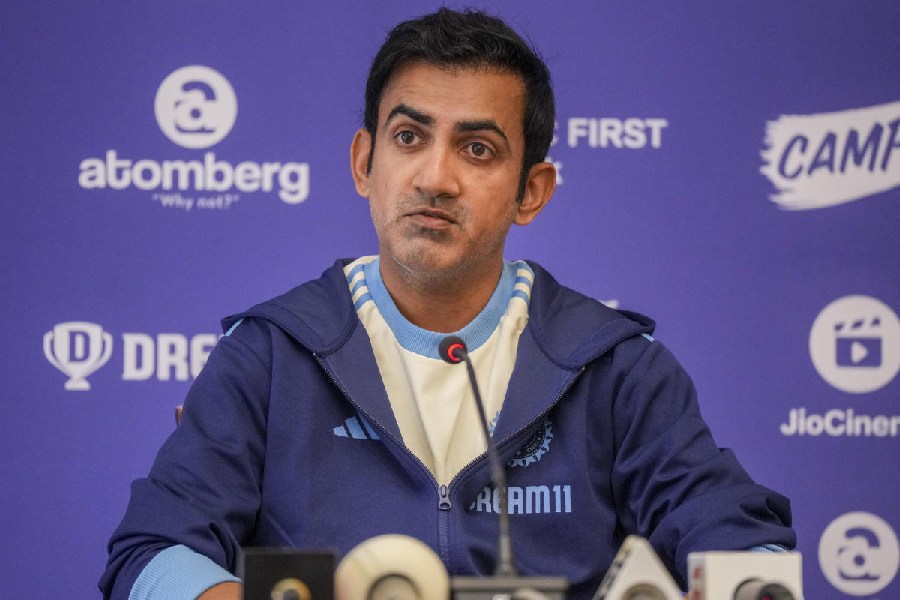 |
| (From left) A meditation class at the Santhi School of Yoga; Poonam Stecher Bhanot in the parivritijanusirsana position; Meera Vaghani does a parivritta trikon asana; at Ashiyana Yoga Retreat, Chris Nelson and his team of teachers practise the naukasana |
“I was in yoga the other day. I was in full lotus position. My chakras were all aligned. My mind was cleared of all clatter and I was looking out of my third eye and everything that I was supposed to be doing. It’s amazing what comes up, when you sit in that silence.”
If Ellen DeGeneres has a few words to say on the art of bending and the spirituality it brings along, the whole world seems to be following suit.
 |
 |
 |
| (From top): An outdoor yoga studio at the Santhi School of Yoga; Kushal Kumar in an ushtrasana (the camel pose); Sanjeev Bhanot helps sister Poonam hold the vashistha asana |
But it’s not just any old form of yoga. The passions du jour are the time-tested traditional styles. The real yoga, that is, that goes back 5,000 years in time. You will see that everyone’s taking to it or looking for it with a rolled-up blue mat tucked under their armpits.
And even as some experiment with the fad forms , the austere forms are making a comeback. “Yoga in its traditional form is life changing,” says Rajvi Mehta, spokesperson for yogi B.K.S Iyengar who is famous for his own particular style of yoga.
One perfect example of how yoga can be life-changing is Nivedita Joshi, the daughter of politician Dr Murli Manohar Joshi, who’s an exponent of Kathak and a yoga instructor in her own right. For years she was almost bedridden after an accident, till she met Iyengar. She started practicing yoga with him and soon she was back on her feet. Now she teaches the Iyengar style of yoga in Delhi.
“For some it’s part of a healing process, and for others a means of attaining a perfectly flexible, toned body. Neither should be a reason for learning this ancient discipline though,” says Santhiprasad, founder of the Santhi School of Yoga in Trivandrum. But he admits that for many out there, yoga is part of their lifestyle. Adds the yogi: “In fact that makes all the difference.”
Whatever be the reason, the new yoga generation is hooked. The mat is their laboratory. Those who have discovered it, ’fess up to starting off with asanas to score a perfect-Madonna body, but somewhere along the way have ended up discovering the spiritual well-being that comes from the ancient discipline.
Go Austere
When we say austere, we simply mean the traditional that has trickled down from sage Patanjali’s Yoga Sutras. “I was introduced to the four main forms — Hatha, Bhakti, Jnana and Karma — in an ashram in the middle of London,” says Chris Nelson, founder of the Ashiyana Yoga Retreat in Goa. While Hatha Yoga alludes to physical postures, the rest are spiritual. So you have Bhakti Yoga which is the yoga of devotion, Jnana the yoga of knowledge and Karma of selfless giving.
At Nelson’s centre, he and his group of yoga teachers retain the essence of the age-old forms but present them in a way that is reflective of modern life. “The beauty of yoga is that it is adaptable and therefore becomes applicable to the times that we live in,” points out Nelson.
 |
| Kushal Kumar balances himself in a sarvangasana |
Cleaning the beach and helping in the kitchen in exchange for accommodation therefore becomes an indication of Karma Yoga at his retreat in the sleepy fishing village of Mandrem in Goa. “Though Karma is selfless giving, ours is a way of showing the idea to people,” adds Nelson who imparts Bhakti Yoga which is practised by way of bhajans and kirtans.
There is a completely non-competitive aspect to yoga that yoga teacher Sanjeev Bhanot insists on. “Everyone has a different personality and body profile. No two people can do an asana the same way,” he insists. It is the reason why he takes Hatha Yoga classes of a few five to seven students together in a quiet studio in the leafy lanes of Delhi’s Defence Colony.
According to Bhanot, who started an internationally recognised institute called Yogalife Foundation, Hatha Yoga makes way for Raja Yoga that takes one towards samadhi (an intense state of concentration). “So ultimately everyone is practising Raja Yoga for they are all preparing you for meditation,” he points out. Bhanot’s institute is going places. The Zurich branch of his foundation is taken care of by his sister Poonam Stecher Bhanot who trained in the Bihar School of Yoga in Munger. There are two more to come up in Germany and China.
In South Calcutta, Meera Vaghani starts her day with suryanamaskar (sun salutation) that warms up the body to follow it up with asanas and pranayama. She says: “It is extremely important that the person should know how far to push his or her body.”
The emphasis at the end of the day is on spirituality. Says yoga expert Kushal Kumar: “Yoga has a 3-tier benefit — physical, mental and spiritual. If you are concentrating on only the physical aspect, it is like being served a full meal and partaking only a small part of it. The best thing is there is no extra effort involved for you to go the full way.”
 |
 |
 |
| (From top) A class in progress at the Santhi School of Yoga; teachers at Ashiyana practise trikonasana while Chris Nelson does a shirshasana in the background; Meera Vaghani demonstrates the ashtavakrasana |
Schooling The Self
The yogic way of life is yours if you want to make your way into the schools of yoga such as the Bihar School of Yoga started by Paramhamsa Satyananda Saraswati. The Munger-based school integrates the ancient forms of Hatha, Raja, Karma, Jnana and Bhakti into its classes.
Meanwhile the Kerala-based Santhi School of Yoga gets across the spirit of yoga through another form of yoga called Kundalini Yoga. “It arouses the latent power known as Kundalini, which resides at the base of the spine, and directs it upward. I train one in the awareness and control of the higher energies,” says Santhiprasad.
The graduation from distress to de-stress comes through with Ashtanga Vinyasa at Pattabhi Jois’s Ashtanga Yoga Research Institute in Mysore. A steady stream of foreigners is common at the institute where the 8-limbed Ashtanga Yoga of Patanjali is taught. “Each student here moves through the practice at his or her own pace and level. We have about six series and one series has as much as 30 asanas,” says Sharmila Rao, Jois’s grand-daughter.
Jois’s students have now started up their own institutions. An example is that of Chad Herst who started AshtangaYoga at Auroville in 2004 along with Monica Marinoni. Located near Pondicherry, Marinoni takes daily classes in the Mysore tradition of yoga. She teams it up with chanting classes from the Yoga Sutras of Patanjali.
The idea of using props in yoga to experience the asanas intensely was hit upon by Iyengar. Cushions, benches, blocks, straps, and even sand bags are his answers to make beginners learn the art of contorting the body with ease.
Standing poses are the most prominent feature of the Iyengar style of yoga that is taught at the Iyengar Ramamani Iyengar Memorial Yoga Institute in Pune.
Breathe Easy
Breathing right is the key thing in yoga. So what you have to look out for when taking yoga classes is to make sure you learn breath control. In yogic terms, the art of lengthening of the breath is known as pranayama.
To give an example of how long the pranayama can be held, Kumar draws in a steady breath for what seems like forever but is in actuality a few seconds. “Yoga has become commercial, so you often see sessions of it being taught without the pranayama,” he warns.
Jois emphasises the fact in his style of Ashtanga Vinyasa. For each movement, there is one breath. “For instance, the Suryanamaskar is composed of nine vinyasas. The first vinyasa is inhaling while raising your arms over your head, and putting your hands together and the second is exhaling while bending forward, placing your hands next to your feet and so on.” Its purpose? Internal cleansing and detoxification.
Individual workshops on breathing are also a regular feature at Ashiyana in Goa. Says Nelson: “The focus is on intense, deep breaths.”
Not For The Faint of Heart
You have surely watched Swami Ramdev on the telly. Hopefully you haven’t tried to imitate him sitting at home because the injuries, yoga masters warn, are grave. The asanas are tough and rigorous and not exactly mastered in a day. It takes time. “You need a teacher to tell you to stop when you are doing it the wrong way,” advises Kushal Kumar, an entrepreneur and yoga teacher who holds workshops for corporate organisations.
How flexible the asanas require you to be comes through as you watch Poonam Stecher Bhanot contort her body into a poorna bhujangasana with her legs bent at the knees and the back of her head touching the toes. Her whole body is supported by the abdomen. “You know your body so much better and it can never not help to know your own body,” says Stecher Bhanot.
“The only requirement is that you come to yoga classes with your stomach empty. It is good to keep a gap of four hours before your last meal and a session of yoga,” says Mehta, the spokesperson for the Ramamani Iyengar Memorial Yoga Institute in Pune.
Daily asanas are recommended. An everyday session of an hour can be enough to keep the energy flowing through the body, Vaghani will have you know. She takes classes at the Solace Gym in Calcutta. For Chad Herst two hours a day, five days a week is perfect. On the other hand, you can go for hours at it. “It depends on how much you can take,” say the Bhanots.
At Jois’ institute in Mysore, it is emphasised that asanas are a build-up for meditation. Says Rao: “While you pick it up, slowly letting your body stretch with each asana, you have to know that yoga is a spiritual practice unlike just pounding it out on the treadmill in a gym.”
The craze for yoga has made it leave behind the realm of the bearded yogis and become a part of the lives of the busy urban yuppies. So all you need to get started is a teacher, a mat and a corner anywhere.
Fad Forms
The unconventional yoga variations are high-octane and tend towards calisthenics
Hot Yoga: Bikram Chaudhary’s style of yoga has gained added popularity in India ever since Kareena Kapoor lost the extra inches by practicing asanas in a heated room.
Power yoga: This fitness buzzword is a misnomer according to most experts. That’s because there’s no breath evaluation in it.
Passion Yoga: It’s about feeling the passion as a series of asanas are done in quick succession in a slightly warm room. It is happening in Mumbai.
Dance yoga: Yoga meets dance as one learns to balance classical poses and mudras with music in the background. It is being taught in Calcutta and Mumbai.
Naked Yoga: Participants actually practice yoga in the buff. Can be seen in the studios of New York.










